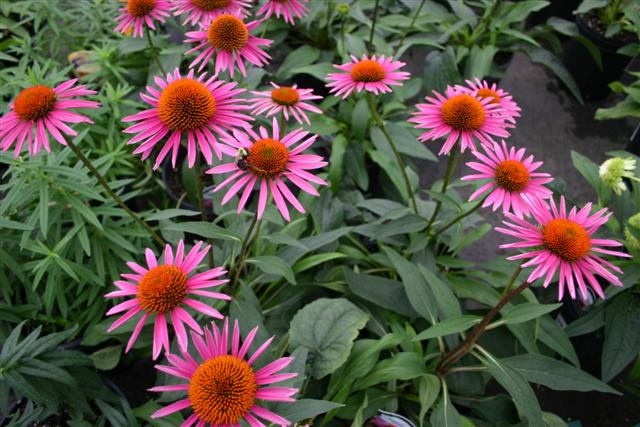Georgia Gardener Newsletter Design Tip: July 24, 2008
Coneflowers
Echinacea spp. |
Echinacea purpurea 'Pica Bella'
In the last 20 or 30 years, the popularity of coneflowers has skyrocketed as the beauty and versatility of these durable
perennials has become well known. Today there are more than two dozen cultivars and hybrids which have been
selected from the nine or so species of coneflower that are native to North America. Most of the coneflowers available
through nurseries are from the species Echinacea purpurea, commonly called the purple coneflower. This plant is
native to the eastern and central parts of the country from Mexico to Canada and is so tough that in parts of its northern
range it can withstand temperatures from -40 to over 100 degrees.
Of the nine species listed by the USDA, sadly six of them are being threatened with extinction, including
three in Georgia:
Smooth Purple Coneflower (E. laevigata): Georgia native - Federal Endangered List
Pale Purple Coneflower (E. pallida): Georgia native - Threatened
Yellow Coneflower (E. paradoxa): Midwest native - Threatened
Sanguin Purple Coneflower (E. sanguinea): Lower Midwest native - Threatened
Wavyleaf Purple Coneflower (E. simulata): Georgia native - Threatened
Tennessee Purple Coneflower (E. tennesseensis): Tennessee native - Federal Endangered List
The common purple coneflower (E. purpurea) is very abundant and because it is one of the easiest coneflowers to grow,
it has received the bulk of the attention from plant growers and breeders.
One of the first purple coneflower cultivars to appear on the market was 'Magnum' known for its larger flowerheads and tall
stature up to 36" tall. The cultivar 'White Swan' was one of the first white coneflowers on the market. These two plants
were both very hardy and worked well in gardens but they were tall, somewhat gangly and tended to be top heavy and flop over.
Dwarf cultivars soon began to appear and one of the earliest ones I used was 'Kim's Knee High' named for Kim Hawks of
Niche Gardens in North Carolina (see notes below).
Several other "Kim" cultivars are also named for her.
Very quickly after the introduction of dwarf purple coneflowers, colors other than purple and white began to appear.
The Big Skytm series of coneflowers developed locally at
ItSaul Plants have taken
coneflowers into a whole new direction by hybrdizing the common purple coneflower with
other species to develop colors that range from orange to red, yellow and pink. Some of these plants also have
the added benefit of being shorter (~24") than their big brothers. Three of the Big Skytm cultivars
that I've grown have been 'Sunrise', 'Twilight' and 'Harvest Moon' (see notes below).
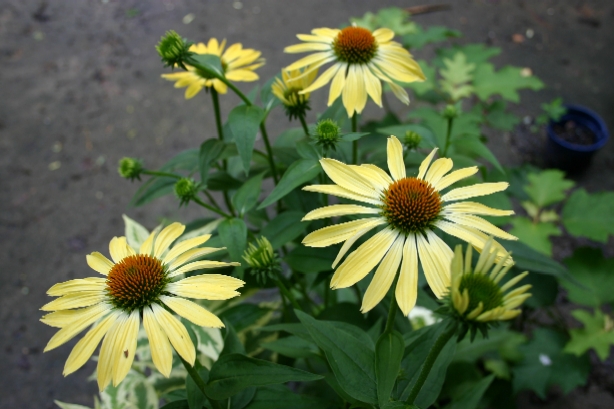 |
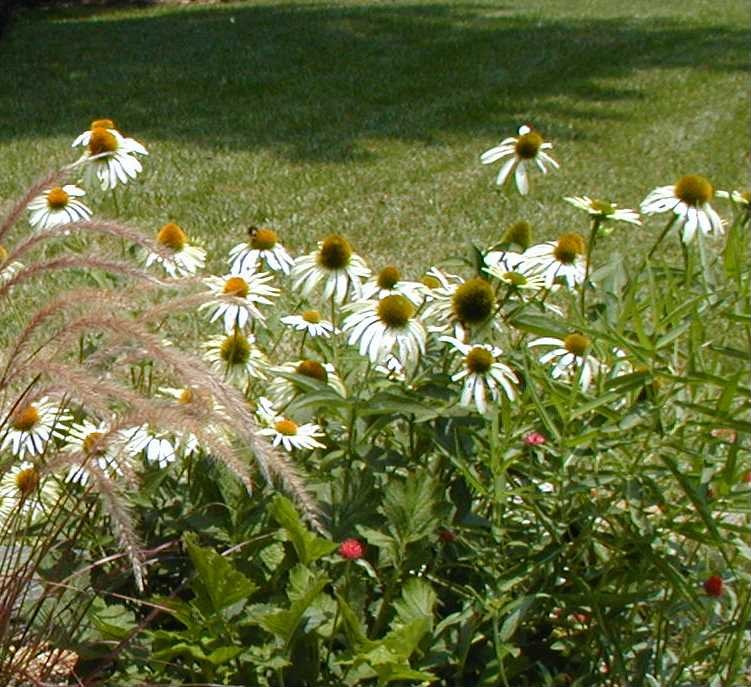 |
| Echinacea 'Sunrise' |
Echinacea purpurea 'White Swan' |
With the availability of shorter coneflowers with a widening range of colors, the popularity of these plants grew to where they
are now one of the most popular perennials in America. New cultivars and hybrids are constantly being developed some of
which have taken on some rather "unique" characteristics of habit and flower shape.
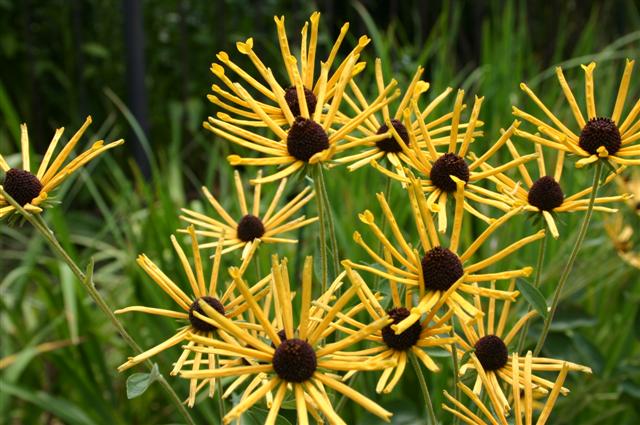 |
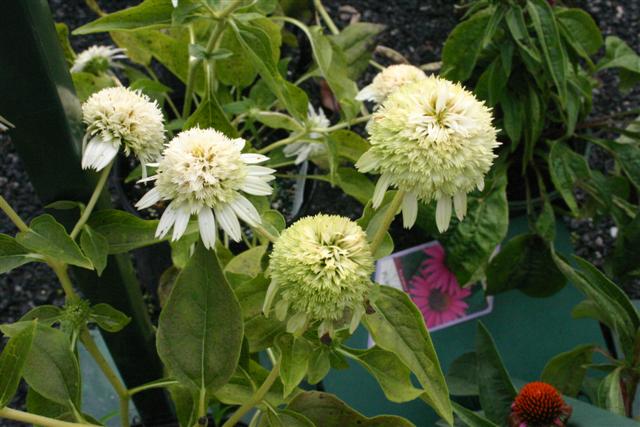 |
| Echinacea paradoxa |
Echinacea 'Coconut Lime' |
Using Coneflowers in the Garden
Coneflowers grow best when planted in full sun in soil that is high in organic matter, loose and well-drained. Make sure
to read the tag of the coneflower that you purchase so that you will site it properly as some can get quite tall.
Blooming usually begins in the early summer and will continue, if deadheaded, well into fall. I usually leave the last flowers
of the season alone as these attract small birds that like to sit on the flowerheads and pick out the seeds. Depending
upon which coneflower you're growing, you may also get seedlings to germinate the following spring.
Use coneflowers in cottage or cutting gardens, wildflower meadows, natural areas, shrub borders, rose and herb gardens, etc. They
are extremely versatile and fit into a wide range of garden styles. Good companion plants include black-eyed Susans,
Indian blanket (Gaillardia spp.), shasta daisies, blazing star (this
newsletter's "Cool Plant'), phlox, lantana, roses, etc.
Pests and Problems
Although generally easy to grow, I've encountered a few problems with my coneflowers. Number one on my list would be an
unnamed tiny beetle that Walter and I have dubbed the
"daisy beetle"
because it eats the leaves and petals of coneflowers, black-eyed susans and shasta daisies. This pest appeared about three
years ago in my garden and has caused lots of damage. I control mine by spraying every 7-14 days with insecticides early in the season
until I start to see the flower buds develop. At that point, I stop spraying in order to protect the health of bees, birds and butterflies.
Usually by this time, the beetle population is well controlled.
The second major problem I've had has been with deer. They love to bite the buds and flowers off the coneflowers. Using repellents
seems to deter them, but it's a constant cat and mouse or deer and gardener game.
The third problem I've been having is with a disease called
"aster yellows". This disease is
spread by the common planthopper insect and is impossible to control. It attacks the same plants as the mystery daisy beetle. The
best course of action for this problem is to remove the entire plant, put it in a plastic bag and out in the garbage. Don't
compost it.
My final problem, which cannot be blamed on the coneflowers themselves, has to do with the use of plant growth regulators by
commercial growers. This is a common practice and not limited to coneflowers. When applied at the growing
nursery, it makes the plants smaller and fuller.
Once purchased and planted in a garden, the plant is no longer exposed to these
chemicals and will grow as nature (and its genetics) intended. Always read the tags on the plants and be suspicious of
any plant that is listed as growing 24 inches tall yet is in full bloom and only 12 inches in height.
Personal Experience
As I said before, I've grown several coneflower cultivars. Below are my personal observations of the plants' performances. Keep
in mind, I've had some pest problems which may have impeded my success.
- 'Magnum': Good, strong, upright plant with 5" flowers; does flop over occasionally.
- 'White Swan': Like Magnum, is a strong grower.
- 'Kim's Knee High': Didn't survive the first winter, but the following year returned either as the original plant or a seedling. I
haven't been very impressed with the toughness of this plant.
- 'Kim's Mophead': This didn't survive the first winter.
- 'Ruby Giant': Excellent large flowers (up to 7"). It rivals Magnum in size and habit.
I'm saddened to say that I've not had good success with the three Big Skytm varieties I've tried:
'Sunrise','Twilight' and 'Harvest Moon'.
I suspect that they may not be as robust as the larger cultivars or the straight species, but in their defense, they were repeatedly
ravaged by deer which may have weakened them to where they didn't survive their first winter. I'm willing to try them again
in a protected fenced area. Stay tuned.
Sources
Coneflowers are widely available from nurseries and mail order sources. There are also quite a few books written about growing
these plants and their medicinal uses. In any case, I recommend trying one or more of the coneflowers available today.
Copyright © 2008 by Theresa Schrum - All rights reserved
No part of this website may be reproduced without the expressed written permission of Theresa Schrum
